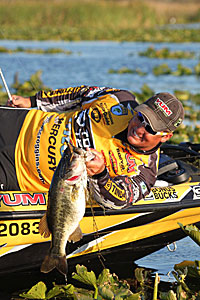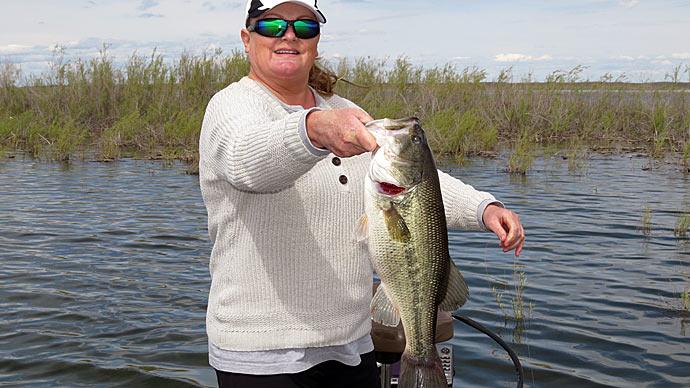
Catchability, how likely a fish is to bite a lure, is a much-discussed issue among anglers and is often referred to as aggressive fish vs. non-aggressive fish. This topic has been debated on several occasions on the Pond Boss website forum and articles have appeared in Pond Boss magazine concerning possible management options for fish that don't bite well. So what are we missing about this aggressiveness trait?
The studies noted below, previously discussed in this column and others, clearly demonstrate that catchability is not limited to largemouth bass. It is also probable in bluegill, catfish, trout, and tilapia populations.
A study entitled Selection for Vulnerability to Angling in Largemouth Bass, by David P. Philipp, et al in Transactions of the American Fisheries Society 138:189-199, 2009, (which I covered in the 4th Cutting Edge article), addressed the issue of whether or not catchability is genetically based through their long-term selection experiment to assess the vulnerability of largemouth bass to angling. That article builds on prior material such as Garrett (2002) Behavioral Modification of Angling Vulnerability in Largemouth Bass Through Selective Breeding, Pages 323-334 in Black Bass Ecology, Conservation, and Management American Fisheries Society Symposium 31, which revealed and quantified the difference in catchability between Florida Largemouth Bass and Northern Largemouth Bass and established that the reduced catchability of the Florida's was passed on to successive generations.
These authors noted that they do not yet understand the mechanism(s) by which genetic selection alters the behavior(s) of the individual. Is it 1) primarily a product of feeding behavior, 2) the product of an individual's general level of aggression, 3) a function of metabolic rates, 4) or some other factor?
Well, now a little more comes to light in a successor study to the one first noted above on the same genetic line of fish. It is a wake up call to all of us to be sure to keep an open mind and think about the bigger picture. It should have been obvious. We should have known that traits are exhibited in many ways and not limited to one aspect of biology, i.e. catchability. The new study is titled Recreational Fishing Selectively Captures Individuals with the Highest Fitness Potential by David A. H. Suttera, Cory D. Suskib, David P. Philippb, Thomas Klefotha, David H. Wahlb, Petra Kerstene, Steven J. Cooke, and Robert Arlinghaus, in Proceedings of the National Academy of Sciences, doi: 10.1073/pnas. 1212536109, October 26, 2012. This follow-up study found that the trait "catchability or vulnerability to angling" positively correlates with 1) aggression, 2) intensity of parental care, and 3) reproductive fitness.
The difference in reproductive fitness between aggressive fish and non-aggressive fish was particularly evident among larger males, which are the preferred mating partners of females and also provide the best parental care. The study further shows that in any given population, the largest and most aggressive males may have the greatest potential fitness, yet these males are also the ones most vulnerable to angling. As a result, largemouth bass populations subjected to angling harvest during the nesting phase can experience the selective removal of those individuals with the greatest potential for high reproductive success and catchability. Because aggressiveness has been shown to be an inherited trait, removing the aggressive male parent so that its offspring are either not hatched or are unprotected as fry and therefore eaten, could result in a significant reduction in the number of aggressive offspring in the population of future generations.
The study notes that fish with higher vulnerability to angling also exhibit higher metabolic rates (feeding and growth), provide more intensive parental care (guarding their nests and fanning their eggs), and show significantly higher aggression toward potential brood predators. Further, larger aggressive males have substantially greater mating success than their smaller aggressive counterparts along with both larger and smaller non-aggressive males, indicating that females were allocating more eggs to larger aggressive males.
This information can be used as a management tool. It indicates that catchability may be improved by removing small, less aggressive nesting male bass, which reduces their genetic footprint (their eggs and offspring are eaten and they are also removed when caught). This would also help reduce overcrowding of small bass which is a common problem in ponds. By not fishing the beds/nests of the first spawning aggressive larger male bass you increase the probability that their offspring live, thus increasing the number of genetically aggressive, catchable fish. Other management options would include using electrofishing equipment, selective rotenone applications, seining, and/or fishing of small non-aggressive male bass nests to reduce their presence.
It should be obvious to all of us by now that there are possibly other fish traits that are genetic and that such traits are exhibited in multiple ways. Do you think that aggressive yearling bass offspring feed with more abandon, taking greater chances that result in them becoming forage for large predators (the "live fast, die young" adage)?
I must stress how important it is to keep an open mind on this journey as there remains much for us to learn. Most pondmeisters think of genetics as something to be used only when purchasing fish for a trophy pond. While that is an appropriate application, we are learning that genetics research coupled with solid fieldwork has many critically important fisheries management applications like catchability. Stay tuned!
Reprinted with permission from Pond Boss Magazine



